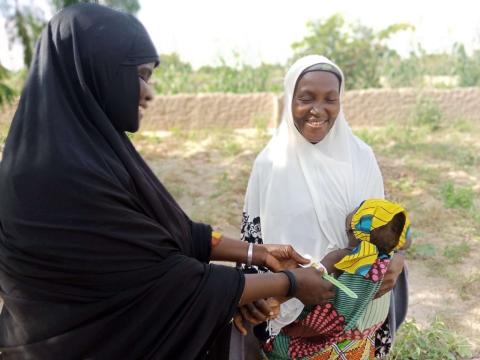The homes of learning and nutritional recovery allow the recuperation of 1,256 malnourished children in the department of Guidan Roumdji in Niger

Nutrition education is an important factor in reducing the risk of malnutrition. As a result, community health workers support and educate young mothers and pregnant women in health and nutrition, as does Halima Labo, a community health worker recruited by World Vision in Garin Koutoubou 1 year ago.
‘’ I became a community health worker to help my community because of the bad harvests. The community has bad eating habits, and that made sure that we have a lot of malnourished children,’’ she said
Indeed, the FARN approach or home of learning and nutritional rehabilitation is a place where mothers of children from 6 to 59 months, malnourished or not, are gathered. They learn how to prepare highly nutritious recipes based on local food. That centre has objectives not only to manage moderately malnourished children but also to prevent malnutrition through the knowledge acquired by mothers in terms of households and which are reproduced at home.
‘’ Since I was recruited, I have been made aware of the young mothers enrolled in the World Vision in collaboration with WFP program to fight against children's malnutrition. We also supervise breastfeeding mothers to allow children to benefit from appropriate physical and mental growth.
To achieve this result, the project launched a first campaign to identify malnourished children. That identification concerned children from 6 to 59 months. To do so, we weighed the children and made them the brachial perimeter measurement test. At the start of activities during awareness campaigns, at least 100 malnourished children could be counted in the village of Garin Koutoubou.
So I started to raise awareness among young mothers to eat properly and, above all feed their children with locally available and more nutritious foods, including beans, liver, egg, and moringa. This is how the nutritional situation of children has experienced a clear improvement since then.
Today we find fewer and fewer malnourished children here in Garin Koutoubou, and the rate of infantile malnutrition has decreased to the point that we only have two children malnourished by exit, '' said Halima with a radiant face, '' she adds:
‘’ In this work, the experience that marked me the most is the case of a girl named Amina. She was 13 months old and was malnourished with 1.6kg. When I met the parents, they thought that their child's condition was due to witchcraft. I spent time chatting with them, and I finally convinced them to bring the child to the nutritional recovery home sessions. After 3 weeks of regular follow-up, the girl's weight increased to 2.1 kg. The parents were very happy to see the change in their daughter. ’’ ’
It should be noted that the results of this project are accentuated by the fact that women benefit from support so that they do not lack the resources to operate these nutritional recovery centres.
‘’ The project accompanies us with food, cereals, legumes, oil, livestock, goats, sheep, etc.
Also, with the pitched sheep, each beneficiary gained more than 50 % profit. Through the market gardener, we were able to produce products intended for consumption but also marketing. All this allowed us to improve our daily lives considerably.
I thank the World Vision WFP project infinitely because I have learned about the change in eating behaviour, and today, I have mastered several culinary recipes to diversify the food of children and improve their nutritional statutes.
I am proud because this project allowed me to raise awareness of women with malnourished children, to treat them at the least cost and save their lives. May God bless this project personally it took me out of poverty because now I trade and the pitfall.’’ Through nutritional recovery homes, 1256 malnourished children were rehabilitated in the department of Guidan Roumdji in the Maradi region.